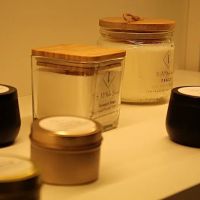Are Scented Candles Toxic? Understanding the Health Risks and Safety Concerns
- 1. Understanding Scented Candles and Their Ingredients
- 2. Potential Risks of Burning Scented Candles
- 3. How Scented Candles Affect Indoor Air Quality
- 4. Choosing Safer Candles: What to Look For
- 5. Real-Life Stories About Candle Safety
- 6. Where to Find Safe Scented Candles
1. Understanding Scented Candles and Their Ingredients
Scented candles are a popular choice for creating a relaxing atmosphere, but many people wonder, "Are scented candles toxic?" The answer depends largely on the ingredients used in the candles. Most scented candles contain wax (usually paraffin, soy, or beeswax), fragrance oils, and a wick. Paraffin wax, which is derived from petroleum, is commonly used but can release harmful chemicals when burned, including benzene and toluene, both of which have been linked to health concerns.
In addition to the wax, the fragrance oils used in many scented candles can contain synthetic chemicals that may cause respiratory irritation or allergic reactions. It's important to understand what your candles are made of to make an informed decision about their safety.
2. Potential Risks of Burning Scented Candles
While the ambiance created by scented candles is soothing, it's crucial to be aware of the potential risks. Some of the dangers of burning scented candles include:
- Release of Toxic Chemicals: As mentioned earlier, paraffin wax can release harmful chemicals when burned. These chemicals can accumulate in your home, particularly in poorly ventilated spaces, and may pose health risks when inhaled over time.
- Indoor Air Pollution: Burning candles, especially those with synthetic fragrances, can degrade indoor air quality. The soot produced by candles can also contribute to particulate pollution in your home, potentially causing respiratory issues, particularly for individuals with asthma or other breathing conditions.
- Allergic Reactions: Some people may experience allergic reactions to the chemicals in scented candles, including headaches, skin irritation, or exacerbated asthma symptoms.
It’s important to remember that the risks associated with candles are generally linked to long-term exposure or burning candles in poorly ventilated areas. By being mindful of where and how often you burn your candles, you can reduce these risks.
id="how-scented-candles-affect-indoor-air-quality">3. How Scented Candles Affect Indoor Air Quality
The air quality in your home can be significantly affected by burning scented candles, especially those made with paraffin wax and synthetic fragrances. These candles release small amounts of chemicals into the air that can cause respiratory irritation, particularly in enclosed spaces. Over time, this exposure may contribute to indoor air pollution, which can be harmful to both humans and pets.
If you burn candles regularly, it's a good idea to ensure that the room is well-ventilated to prevent the buildup of harmful particles. Opening a window or using an air purifier can help improve the air quality in your home while still enjoying your candles.
4. Choosing Safer Candles: What to Look For
If you love candles but are concerned about their potential health risks, there are safer alternatives available. Here are some tips for choosing safer candles:
- Opt for Soy or Beeswax Candles: Soy and beeswax candles are natural alternatives to paraffin wax. These candles burn cleaner and produce fewer harmful chemicals. Beeswax candles, in particular, can even help purify the air by releasing negative ions that bind with dust and other particles.
- Choose Non-Toxic Fragrances: Look for candles made with essential oils or natural fragrances instead of synthetic ones. Essential oils are generally safer and provide the same delightful scents without the harmful chemicals found in many synthetic fragrances.
- Check for Lead-Free Wicks: Some older candles may have wicks with lead, which can release toxic fumes when burned. Make sure your candles are made with lead-free wicks, often marked as "cotton" or "wooden" wicks.
By choosing high-quality, natural candles, you can enjoy the ambiance without the health risks associated with cheaper alternatives.
5. Real-Life Stories About Candle Safety
Many people have experienced the negative effects of scented candles, particularly those made with synthetic chemicals. For example, Emily, a pet owner, used to burn scented candles daily in her home, but her dog began showing signs of respiratory distress. After switching to natural, soy-based candles, her dog's symptoms improved significantly. Emily realized that the synthetic fragrances in traditional candles were causing the issue, and she now uses only non-toxic alternatives.
Similarly, Mark, an asthma sufferer, used to light candles frequently but found that the soot and chemicals released from burning paraffin candles would trigger his symptoms. After switching to beeswax candles, he noticed a significant improvement in his breathing and overall comfort in his home.
6. Where to Find Safe Scented Candles
If you're looking for safer, non-toxic scented candles, visit Scent Snob for a selection of high-quality, natural candles made with soy, beeswax, and essential oils. Scent Snob offers a variety of scents that are both safe and enjoyable, allowing you to indulge in the cozy ambiance of candles without compromising your health.
Explore their collection of natural candles and find the perfect scent for your home. With Scent Snob, you can enjoy the beauty and warmth of candles while ensuring that you and your family are breathing clean, safe air.



0 comments